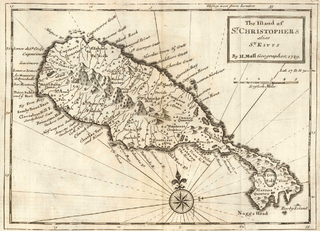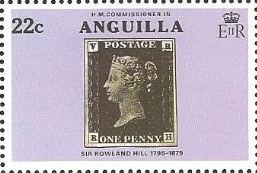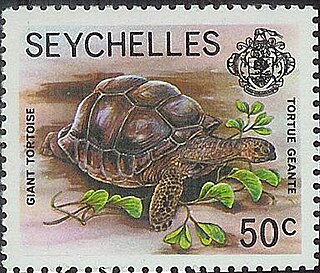
Saint Kitts and Nevis, officially the Federation of Saint Kitts and Nevis, is an island country consisting of the two islands of Saint Kitts and Nevis, both located in the West Indies, in the Leeward Islands chain of the Lesser Antilles. With 261 square kilometres (101 sq mi) of territory, and roughly 50,000 inhabitants, it is the smallest sovereign state in the Western Hemisphere, in both area and population, as well as the world's smallest sovereign federation. The country is a Commonwealth realm, with Charles III as King and head of state.

Saint Kitts and Nevis have one of the longest written histories in the Caribbean, both islands being among Spain's and England's first colonies in the archipelago. Despite being only two miles apart and quite diminutive in size, Saint Kitts and Nevis were widely recognized as being separate entities with distinct identities until they were forcibly united in the late 19th century.
The history of Anguilla runs from the beginning of human habitation, probably via settlement from South America, through its colonization by the English in the early modern period, to the present day. Following a series of rebellions and a short-lived period as an independent republic during the 1960s, Anguilla has been a separate British overseas territory since 1980.

The British West Indies (BWI) were colonised British territories in the West Indies: Anguilla, the Cayman Islands, Turks and Caicos Islands, Montserrat, the British Virgin Islands, Antigua and Barbuda, The Bahamas, Barbados, Dominica, Grenada, Jamaica, Saint Kitts and Nevis, Saint Lucia, Saint Vincent and the Grenadines, British Guiana and Trinidad and Tobago. Other territories included Bermuda, and the former British Honduras.

The British Leeward Islands - Antigua, Dominica, Montserrat, Nevis, St. Christopher, and the Virgin Islands all used postage stamps inscribed "LEEWARD ISLANDS" between 1890 and 1 July 1956, often concurrently with stamps inscribed with the colony's name.

Saint Christopher-Nevis-Anguilla was a British colony in the West Indies from 1882 to 1983, consisting of the islands of Anguilla, Nevis, and Saint Christopher. From 1882 to 1951, and again from 1980, the colony was known simply as Saint Christopher and Nevis. Saint Christopher and Nevis gained independence in 1983 as the Federation of Saint Kitts and Nevis, while Anguilla would remain a British overseas territory.
Each "article" in this category is in fact a collection of entries about several stamp issuers, presented in alphabetical order. The entries themselves are formulated on the micro model and so provide summary information about all known issuers.
Each "article" in this category is a collection of entries about several stamp issuers, presented in alphabetical order. The entries are formulated on the micro model and so provide summary information about all known issuers.

West Indies Associated States was the collective name for a number of islands in the Eastern Caribbean whose status changed from being British colonies to states in free association with the United Kingdom in 1967. These states were Antigua, Dominica, Grenada, Saint Christopher-Nevis-Anguilla, Saint Lucia, and Saint Vincent.

The British Leeward Islands was a British colony from 1671 to 1958, consisting of the English overseas possessions in the Leeward Islands. It ceased to exist from 1816 to 1833, during which time it was split into two separate colonies. It was dissolved in 1958 after the separation of the British Virgin Islands, and the remaining islands became parts of the West Indies Federation.

The monarchy of Saint Kitts and Nevis is a system of government in which a hereditary monarch is the sovereign and head of state of Saint Kitts and Nevis. The current monarch of Saint Kitts and Nevis, since 8 September 2022, is King Charles III. As sovereign, he is the personal embodiment of the Crown of Saint Kitts and Nevis. Although the person of the sovereign is equally shared with 14 other independent countries within the Commonwealth of Nations, each country's monarchy is separate and legally distinct. As a result, the current monarch is officially titled King of Saint Christopher and Nevis and, in this capacity, he and other members of the royal family undertake public and private functions domestically and abroad as representatives of Saint Kitts and Nevis. However, the King is the only member of the royal family with any constitutional role.
Antigua was discovered by Christopher Columbus, in 1493, and was named after the church of Santa Maria la Antigua in Seville. It was first settled in 1632. By the Treaty of Breda in 1667 it became a British Possession.

Anguilla is a British overseas territory in the Caribbean, one of the most northerly of the Leeward Islands in the Lesser Antilles. It consists of the main island of Anguilla itself, together with a number of much smaller islands and cays with no permanent population.

Nevis, a British colony in the Leeward Islands, began issuing stamps in 1861.
This is a survey of the postage stamps and postal history of Grenada.

This is a survey of the postage stamps and postal history of Seychelles, a 115 island nation spanning an archipelago in the Indian Ocean, some 1,500 kilometres (932 mi) east of mainland Africa, northeast of the island of Madagascar. Seychelles was administered as a dependency of Mauritius from 1810 to 1903. Independence was granted in 1976.

Revenue stamps of the Leeward Islands were issued by the British Leeward Islands between 1882 and the 1930s. They were used on Antigua, the British Virgin Islands, Dominica, Montserrat and Saint Kitts and Nevis, all of which also issued their own revenue stamps before, during or after they used common issues for the Leeward Islands.

The primary law governing Saint Kitts and Nevis nationality regulations is the Saint Christopher and Nevis Citizenship Act, which came into force on 28 February 1984.













